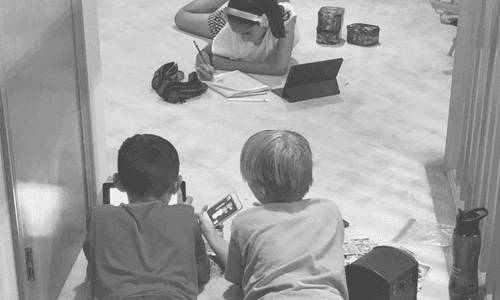How to Create a Family Tech Plan Everyone Can Agree On

Anyone else a fan of the Holderness Family? Their timely videos perfectly capture the reality of family life! Here’s one of their latest about a video game:
Screen Time: What our family argues about most.
It’s the most contentious topic in our house right now, and I’m sure it will be for some time. I’m trying hard not to raise tech-addicted zombies who lack social skills, but I’m also trying hard to make sure they are adept and skilled at technology use because future careers largely depend on it.
I’ve spent a lot of time on new strategies to limit their screen time and find a healthy balance, but I haven’t really focused much on having conversations with them about the struggle that’s happening inside my head.
My middle schooler and I had a pretty big argument about his use of a school-issued laptop. We’re not only battling video games and YouTube videos, but now it’s extended to more time during the school day and most homework assignments. Even my elementary schooler has a school-issued tablet.
On its face, this isn’t a bad thing. There are so many benefits and I’m glad my kids have an opportunity to learn and keep up with technology developments. The fact that this definitely isn’t the case for everyone isn’t lost on me. I know it’s a privilege.
Let’s stop arguing. And start talking.
But after that argument, I’d had it. A friend had just posted a powerful Nature Valley commercial on Facebook. So I decided to sit down with my son and watch it.
When it was done, he was silent for a while. And then he gave me a hug and said he was sorry. That he shouldn’t have been so upset. That he realized his reaction was a problem.
I hugged him and forgave him, but knew full well this wouldn’t be the last argument about technology. And I told him that. I said I knew he would still get angry and think our rules were ridiculous, and that’s okay. He doesn’t have to agree and he doesn’t have to like it.
What I do want, however, is his participation in the process of deciding how to find a balance.
We need a plan.
I’m an educator, so I love suggestions based on both research and people’s first hand experiences, so if there’s a model or a clear process to help with something, I gravitate toward it. I’ve been living and breathing the service-learning model lately, so I wondered if that might help.
So if you’re serious about figuring this tech thing out once and for all, and you want to involve your kids in the process, here’s our 5-step guide to developing a technology plan as a family. Let your kids take some ownership. It will help you shift away from arguments and move toward discussion–so bonus lessons on communication, conflict resolution, and compromise!
STEP 1: Investigate
Look in the mirror at your own technology use.
Take some time to evaluate your own use of technology. It’s not easy to honestly look at how much time we, as parents, spend on our phones and computers outside of work time. One of my go-to websites/blogs/podcasts for technology information is Cool Mom Tech, and Kristen Chase wrote an insightful post about what she realized when she put down her phone.
STEP 2: Plan and Prepare
Start a conversation about screen time and make a plan as a family.
Tell your kids what you learned about your own dependence on technology, and then use some of these questions to start a conversation. My kids had some surprising and insightful answers.
- How have computers, tablets, phones and gaming systems made our lives better or easier?
- How does technology use make our lives less meaningful or harder?
- How much time do you spend on devices each day?
- How do you feel when I spend a lot of time on my phone or computer? (Brace yourself…the answer might be hard to hear. Ask anyway. It’s a vital part of the conversation.)
- What do you miss out on when you choose technology over other things?


Use this discussion to help your family develop a plan for technology use. There’s no right or wrong here. Do what works best for your family. We decided on one plan for weekdays and another for weekends. We ALL had to compromise to settle on a plan that everyone could support.
For more ideas, see this Huffington Post article about technology and the family and this NPR article with advice from screen time experts.
STEP 3: Act
Put your plan in action.
Make a commitment as a family to stick to the tech plan for a week, two weeks, a month. You decide. Developing a new habit is hard work and this Forbes article says you’ll need to go through several stages to get there. If it helps you, choose rewards for days when you did well, or consequences for not sticking to the plan.
STEP 4: Reflect
Get back together as a family to talk about what worked and what didn’t.
Oh, I could go on forever about the importance of this step! The teacher in me wants to leap onto a desk and give an impassioned speech, like Robin Williams in Dead Poets Society.
Instead, I’ll just say that we as a society do a pretty terrible job of stopping, thinking, considering. We move too fast to spend time thinking about what we learned. We check something off our list and move on to the next task.
Teach yourself–and your kids–to reflect. Ask more questions:
- What did you learn since we started?
- What was the hardest part of our new plan? What was the easiest?
- What do you think we should keep and what should we change about our plan?
STEP 5: Demonstrate
Make the adjustments to your family technology plan and tell at least one other person about your new approach.
The other thing we tend not to do? Adjust. We’d often rather give up or start over. Don’t waste your family’s effort! Use what you learned when you reflected, make adjustments and put your new and improved plan into practice.
And if your plan worked or you learned something valuable, don’t keep all that wisdom and insight to yourself! Share it with someone else. Serve another family by telling them what you learned.
Mary and I believe in this process. In investing in your family, asking questions and listening to the answers, improving communication skills, teaching your kids to resolve conflict in a healthy way, learning how to compromise.
Are you ready to take the next step?
If you’re ready to make this kind of commitment to your family and your kids, we would love to help you!
Your kids will always remember the time you spent together. More than the time they spent on a screen.











